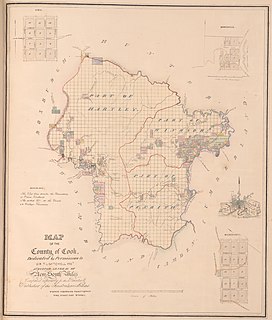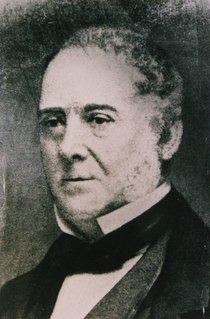Related Research Articles

Cook and Westmoreland was an electoral district of the Legislative Assembly in the Australian state of New South Wales in the first and second Parliaments (1856–1859), named after Cook and Westmoreland counties in the Blue Mountains, Lithgow and Oberon areas. It elected two members simultaneously, with voters casting two votes and the first two candidates being elected. It was largely replaced by Hartley, however both members moved to other electorates, James Martin became the member for East Sydney, while Robert Jamison became the member for Nepean.
North Eastern Boroughs was an electoral district of the Legislative Assembly in the Australian state of New South Wales from 1856 to 1859, that included the towns of Newcastle, Stockton and Raymond Terrace. It was partly replaced by the electoral district of Newcastle and the electoral district of Hunter.
Northumberland and Hunter was an electoral district for the Legislative Assembly in the Australian state of New South Wales from 1856 to 1859, in the Newcastle area and named after Northumberland County and the Hunter River. It elected three members, with voters casting three votes and the first three candidates being elected. For the 1859 election it was replaced by Northumberland and the remainder was divided between Hunter and Lower Hunter.
Western Division of Camden was an electoral district for the Legislative Assembly in the Australian state of New South Wales from 1856 to 1857. Its name was changed to West Camden between 1858 and 1859, when it was replaced by the electoral district of Camden. It elected two members simultaneously, with voters casting two votes and the first two candidates being elected. The electorate was based on western Camden County, which adjoins the Cumberland County to the south, including the Southern Highlands and, to the east, the Illawarra.

Gloucester and Macquarie was an electoral district of the Legislative Assembly in the Australian state of New South Wales in the first and second Parliaments (1856-1859), named after Gloucester and Macquarie counties on the Mid North Coast. It was abolished in 1859 with Macquarie, the north-east of Gloucester and the Macleay River area forming the new district of Electoral district of Hastings, while the rest of Gloucester was split between Lower Hunter, Northumberland and The Williams.
King and Georgiana was an electoral district of the Legislative Assembly in the Australian state of New South Wales from 1856 to 1859, named after King and Georgiana counties, including Yass and Taralga. Its only member was Peter Faucett. It was largely replaced by the electoral district of Yass Plains in 1859.
Shoalhaven was an electoral district for the Legislative Assembly in the Australian state of New South Wales from 1859 to 1904. It included the lower part of the Shoalhaven valley. It replaced parts of Eastern Camden and St Vincent. It was replaced by Allowrie.
Eastern Division of Camden was an electoral district for the Legislative Assembly in the then British colony of New South Wales from 1856 to 1857. Its name was changed to East Camden in January 1858, and it was largely replaced by the district of Illawarra in June 1859.
New England and Macleay was an electoral district of the Legislative Assembly in the Australian state of New South Wales from 1856 to 1859, in the Northern Tablelands region of New England and part of the Mid North Coast region, including the area to the north of the Macleay River. but excluding the area south of the Macleay River which was included in the Counties of Gloucester and Macquarie. To the north was the electorate of Clarence and Darling Downs and to the west the electorate of Liverpool Plains and Gwydir. It elected two members, with voters casting two votes and the first two candidates being elected. It was partly replaced by New England.
Western Boroughs was an electoral district for the Legislative Assembly in the Australian state of New South Wales from 1856 to 1859. It included the towns of Bathurst, Carcoar and Kelso, while the surrounding rural areas were in Bathurst (County) and Cook and Westmoreland. It was replaced by Bathurst and Carcoar.
John Fletcher Hargrave was a British-born Australian politician and judge.
Members of the New South Wales Legislative Assembly who served in the second parliament of New South Wales held their seats from 1858 to 1859. </ref> The Speaker was Sir Daniel Cooper.
The second Cowper ministry was the fourth ministry of the Colony of New South Wales, and second occasion of being led by Charles Cowper.
Camden, an electoral district of the Legislative Assembly in the Australian state of New South Wales, has had two incarnations, from 1859 to 1920 and from 1981.
Illawarra, an electoral district of the Legislative Assembly in the Australian state of New South Wales, has had three incarnations, the first from 1859 to 1904, the second from 1927 to 1968 and the third from 1971 to 2007.

Robert Owen was a politician, solicitor and judge in colonial New South Wales; a member of the New South Wales Legislative Assembly, and later, the New South Wales Legislative Council.
The 1858 New South Wales colonial election was to return 54 members of Legislative Assembly composed of 34 electoral districts with 18 returning 1 member, 13 returning 2 members, two returning 3 members and one returning 4 members, all with a first past the post system. In multi-member districts, because each voter could cast more than one vote, it is not possible to total the votes to show the number of voters and voter turnout in these districts is estimated. 17 members from 14 districts were returned unopposed. The electoral districts and boundaries were established under the Electoral Act 1851 (NSW) for the former Legislative Council.
A by-election was held for the New South Wales Legislative Assembly electorate of Eastern Division of Camden on 15 March 1859 because Robert Owen's seat was declared vacant on his acceptance of an appointment as a judge of the District Court, filling the position created by the resignation of John Hargrave. The Illawarra Mercury reported that the nomination of John Tighe was intended to cause one week's delay before Hargrave could take his seat.
Western Division of Camden, an electoral district of the Legislative Assembly in the Australian state of New South Wales was created in 1856 and abolished in 1859.
The 1859 New South Wales colonial election was for 80 members representing 67 electoral districts. The election was conducted on the basis of a simple majority or first-past-the-post voting system. In this election there were 9 multi-member districts returning 22 members and 58 single member districts. In the multi-member districts each elector could vote for as many candidates as there were vacancies. 15 districts were uncontested.
References
- ↑ Green, Antony. "Elections for the District of East Camden". New South Wales Election Results 1856-2007. Parliament of New South Wales . Retrieved 23 August 2020.
- ↑ Part 5B alphabetical list of all electorates and Members since 1856 (PDF). NSW Parliamentary Record. Parliament of New South Wales . Retrieved 18 December 2019.
- ↑ "Mr John Marks (1827-1885)". Former Members of the Parliament of New South Wales . Retrieved 18 April 2019.
- ↑ "Mr Henry Osborne (1808 - 1859)". Former Members of the Parliament of New South Wales . Retrieved 12 April 2019.
- ↑ "Mr Robert Owen (1799-1878)". Former Members of the Parliament of New South Wales . Retrieved 11 March 2019.
- ↑ "Mr John Fletcher Hargrave, QC (1815-1885)". Members of the Parliament of New South Wales . Retrieved 11 March 2019.
- ↑ Green, Antony. "1859 East Camden by-election". New South Wales Election Results 1856-2007. Parliament of New South Wales . Retrieved 19 June 2019.
- 1 2 Green, Antony. "1858 Camden East". New South Wales Election Results 1856-2007. Parliament of New South Wales . Retrieved 12 June 2019.
- ↑ "Writ of election: Eastern Division of Camden". New South Wales Government Gazette . No. 38. 8 March 1859. p. 542. Retrieved 19 June 2019– via Trove.
- ↑ Green, Antony. "1856 Eastern Division of Camden". New South Wales Election Results 1856-2007. Parliament of New South Wales . Retrieved 21 March 2015.